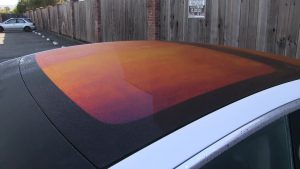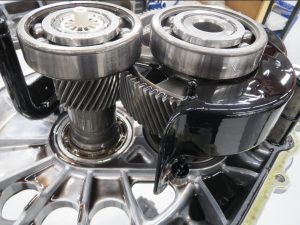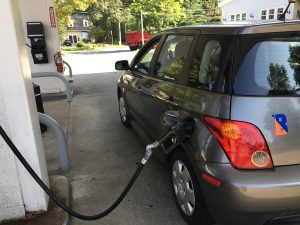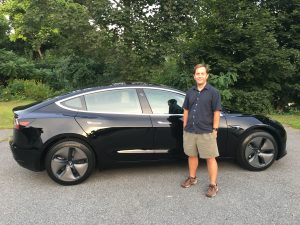I just crossed 2,000 miles with my Tesla Model 3, so I thought I’ve had enough experience with it to share some thoughts on it.
First, a disclaimer: I’m not a car guy. I view cars as a way to get from where you are to where you want to go. I really don’t care about 0-60 acceleration time, torque or other flashy features that don’t add significant convenience. I do like geeky tech toys though so far as cars go, the Model 3 is the ultimate toy.
Buying a Car in only 880 Days
I reserved my Model 3 with a $1,000 (refundable) deposit over 2 years ago, on March 31, 2016, even before Elon Musk made his presentation that unveiled the car. On April 13, 2018, I got an email from Tesla that invited me to actually place the order for the car. I held out until June 30 which was the last day they included unlimited data for maps and streaming music.

Cora goes for a test drive while we wait to do the paperwork at the Tesla dealership
Tesla called on July 11, informing me that my car would be ready for delivery soon. Unfortunately the car was going to be ready on August 5 and I was would be on vacation until the 18th. They would only hold the car for me for 10 days, so I had to pass on that particular car and wait for one to be available when I got back.
On August 23, they called again and said my car was in Dedham, Mass. and had been ready for a few days! Given that, I had to get everything ready quickly before 10 days had passed again. On the morning of August 28, signed my name a bunch of times and drove away with my MAGICAL SPACE CAR, one of the first 57,000 built.
The Design
The car is beautiful. Every time I walk up to it, I can’t believe it’s MY car. The cabin rises up off the hood in one big swoop that comes back down at the tail. It’s stylish, but not ostentatious.
The interior is extremely clean, particularly the dashboard. Nearly all the controls are on the giant touchscreen. There’s only one button NOT on the touchscreen – the hazard light button up on the headliner. Apparently that has to be a physical button by law.

The UV coating on the roof looks really cool when wet.
The thing that amazes me the most about the Model 3 is how they’ve managed to take a car with such complicated technology and make the interface so minimal. Regular cars with their dozens of buttons on the dashboard look ridiculously and hopelessly complicated to me now.
The all-glass roof looks like a regular roof from the outside, but is very impressive from the inside. It’s great for passengers, but I don’t spend much time staring at the sky while I drive. It’s tinted well enough that it’s never too bright in sunlight and there’s no glare on the display.
There’s a UV coating on the top glass that makes cool orange rainbows when it’s wet. Some earlier Model 3s have the coating halfway down the back glass too, but it doesn’t make a difference to me.
Getting In and Out
The car has two forms of keys – an app on your phone that communicates via Bluetooth and two key cards that use NFC. My last car didn’t even remote entry, so I skipped the key fob entirely and went to not needing to carry a “key” at all. That’s also taken some getting used to as I was accustomed to patting down my pockets for my keys before I went somewhere.
I have used the key card once when my phone was completely dead, so it’s important to keep in your wallet.
The car “starts” when you have a key nearby and put your foot on the brake. The car turns off when you stop and get out. I’m so used to this now that when I drive our other car, I forget to turn it off and I’ve wandered away with it on and still in drive. Oops.
The car can also be set to lock automatically when you and your phone leave Bluetooth range. It emits a short honk to confirm so I really don’t need to take out my “keys” anymore. Support for a traditional key fob is coming soon, but I really don’t miss carrying one around.
Voice Control
In an age where voice assistants that can access the whole world’s information are everywhere, the voice controls in the Tesla are shockingly simple. It can respond to only 3 commands:
“Navigate to <location>”
“Play <song or artist>”
“Call <contact>”
That said, the voice recognition is surprisingly accurate, especially when finding locations or weirdly spelled songs. The speech is also quite good. It pronounces ‘Worchester’ right and I swear it inserts a slight ‘w’ sound into ‘Boston’.
The Audio System
The sound system is easily the best of speakers I own. It’s loud, crisp and clear. While I usually listen to podcasts when I drive, I listened to music exclusively for the first two weeks. I just loved the sound quality and as someone who doesn’t subscribe to any music services, I enjoyed listening to any song on demand through the Slacker premium subscription that comes with the car.
Slacker itself is alright. As you thumbs up songs, it builds up a “favorites” station that will play those songs and others you’ll probably like. It would be nice if you could listen to just one artist or album with the built-in subscription plan. I’ve also noticed quite a few songs that have noise in them from a bad encoding which is annoying.
The car also has podcasts via TuneIn, but there’s no way to control the playback speed which I rely on to rip through more podcasts at twice the normal speed.
So despite having a car with built-in navigation, music and podcasts, I still use the apps on my phone for those functions instead.
It’s an Automatic

Model 3 gears
Even while it can’t completely drive itself, there’s a lot that it does automatically. The headlights turn on automatically but also the high beams. It unlocks automatically when you get close with your phone and locks when you leave. The seat moves to a position that makes it easier to get out when you put it in park and moves to driving position when you get in and put your foot on the brake. The wipers turn on when the windshield gets wet. The audio system changes the volume based on road noise.
You don’t need to switch gears which would classify it as a having automatic transmission, but that’s because it only has one gear. There’s no transmission!
Autopilot: Cool, but Potentially Dangerous
“Autopilot” sounds like the car can drive itself. That’s a bit over-marketed. What It can do today is drive in a well-marked lane, maintain a distance from the car in front of you (adaptive cruise control), and safely change lanes for you after you turn on the signal.
You cannot say, tell the car to drive you to work, and read a book until you’re there. It doesn’t follow the car’s built-in navigation or read lights and traffic signs. Tesla is working on that and when full self-driving is ready and approved by governments, it will cost a couple thousand dollars to enable it. It will be amazing if it even happens.
Autopilot as it exists now is nice though, and I’m glad I bought the additional feature. It’s nice to relax a bit while driving on a highway, taking my feet off the pedals and lightly holding the wheel. In other Tesla cars, the car confirms you’re still there by detecting squeezing force on the steering wheel. People defeated this by shoving something in the wheel. The Model 3 measures your slight resistance as it turns the wheel for you which is much harder to work around. There’s also a camera, currently unused, above the rear view mirror which someday could be used to recognize that you’re awake and alert.
You can either turn on just the adaptive cruise control or also turn on autopilot.
In its current form, adaptive cruise control and autopilot can be dangerous, but it’s not the car’s fault.
In practice, you end up turning adaptive cruise control and autopilot off and on quite a bit which makes it easy to forget which mode you’re in. Both modes are indicated clearly on the display, but several times I’ve forgotten that I had to turn cruise control or autopilot off and suddenly realized the car wasn’t going to turn or slow down for some other car. It will also ruthlessly cut off other cars who are trying to merge into your lane.
It will probably be some time before I get used to all that.
Charging and Fuel Costs

The last fillup for my old car
Tesla realized if it was going to bring electric cars into the mainstream, they had to make it easy. So if you enter a destination in the car and you won’t have enough electricity to get there, it will automatically add a stop for a supercharger along the way.
Using a supercharger is a one-step process. You plug it in and let it charge. The session is billed to your credit card on file. When you’ve filled your battery all the way up or have enough to get to your destination, you just unplug and drive away. It’s far easier (though slower) than stopping at a gas station.
I’ve only used a supercharger once so far. I plugged it in, got some dinner, went to an ATM and drove off 37 minutes later. In that time, it added 155 miles of range and 480 kw to my battery at a cost of $7.80. That’s $0.16/kwh, which is fairly cheap. If you assume that gas is about $3/gallon, that’s the equivalent of 65 mpg.
I’ve done all of my other charging at home from a regular outlet . I’m still debating about getting a high-speed charger installed in my garage.I get 4 miles of range added per hour out of my 110 volt outlet, That just about covers my daily commute. Whatever I don’t recover, I can easily make up on weekends when we’re usually going places together in our minivan.
With a high-speed charger that adds 30-40 miles/hour, I could get away with charging only once or twice a week. One estimate I got was for $1,200 which seems like a lot for the convenience, so I think I’ll skip it for now and pay to use a supercharger or other public charger as needed.
But again, Tesla makes it really easy to charge, even at home. The charger plug handle has a button that acts as a remote control for the charging port door. You just get close, hit the button and plug in the charger in a completely one-handed operation.
At home, my electricity rate averaged $0.21 per kWh over the last year. The car keeps track of your efficiency by trip and overall. Over my 2,072 miles, I’ve used 535 kWh or 258 Wh/mi which comes out to $0.05 per mile. If you assume gas is $3/gallon, that’s the equivalent of 55 mpg. My little Scion xA only got 34 mpg (even at 1,500 lbs lighter), so I’m now spending roughly half as much on “gas”.
The solar panels we had installed on our house a few years ago covered all of our electricity usage. With the additional usage charging the car, I expect that to drop to around 80%, but that will still make my effective electricity rate $0.04 kWh.
I still haven’t gotten out of the habit of checking to see if I need gas whenever I drive by a gas station. Perhaps once there’s more superchargers around, I won’t feel so silly.
An Amazing Car, but not Flawless
The owner forums and groups are full of stories of manufacturing problems, but I can’t find any issue with mine. I do have issues with some of the design choices made in the car.
First, I’m not a fan of the door handles. It requires pushing in the right side with your thumb and then awkwardly grabbing the opposite side that tilts out. With pretty much every other door handle on the planet, all you have to do is grab anywhere on the handle and pull open the door.
The side mirrors are pretty small. I feel like I’m always moving my head around to see different angles in the mirror and confirm that lanes are open.

The frunk isn’t useful for transporting children
The frunk isn’t very useful. The storage space inside is small and requires a lot of force to close the hood. The manual warns you to not push down on the wrong parts of the hood as to not damage it which is worrisome. That said, the rear trunk is pretty big even without the large sub trunk area where a spare tire might go on other cars.
The trunk gate is completely manual. I’m surprised it doesn’t at least automatically latch as I’ve mistakenly thought it was completely closed a few times.
If you’re a fan of Apple CarPlay or Android Auto, you’re out of luck. The integration with your phone is limited to phone calls, your address book, showing your calendar and playing music via Bluetooth. You can’t even browse the music on your phone like an iPod.
The navigation is OK, but Waze is better so I end up still using Waze for commuting.
Finally, the seats are killing my back. No matter how I adjust them, my back is sore after any drive longer than a half hour. I think the problem is that the seats are deep on the bottom and fairly convex on the back, putting a lot of pressure on my lower back.
Even with those flaws, I’m still a big fan of this car. For one, unlike pretty much every other car on the road, it will get better with time. Since I’ve gotten the car, I’ve already gotten software upgrades that enabled a dashcam and a web browser. A blind spot camera view will probably come in a future update. Perhaps it will get better integration with your phone.
2,000 miles later…

Me and my newest toy
This is the first car I’ve ever bought without a test drive. In fact, I never even got inside one until about 30 minutes before I bought 0ne. So far, I have no regrets.
I’ve caught a few people eyeing my car, much like I did before I got one. I’ve seen at least one person take a picture. It seems like every day I see more and more Model 3s on the road. As production costs come down and the $35k model becomes available, it may be impossible to go anywhere without seeing them. When Model 3s become as common as Honda Accords, the electric car of the future will become the car of the present. I’ll be happy to have lived in the future for just a little bit longer than everyone else.
Hey Jeff Boulter I know this is an old post but how is the Tesla holding up now
Still doing great!